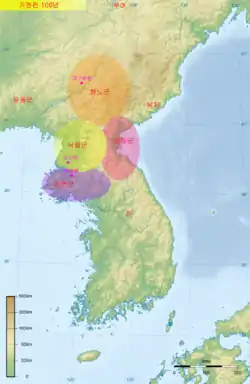Gaogouli County
Gaogouli County (高句驪縣; Goguryeo County or Koguryo County in Korean) was a county under the administration of Xuantu Commandery located in southern Manchuria and the northern Korean peninsula.[1][2][3] It was established by the Han dynasty after its conquest of Gojoseon to keep the tribes of Goguryeo in check.[4] In 75 BC, Xuantu Commandery was forced to move its seat of power from Fort Okjeo to Gaogouli County due to Yemaek raids. From 75 BC to 12 AD, Goguryeo tribes were under administration of Gaogouli County and engaged in tributary relationship with the Han dynasty.[3] In 12 AD, Goguryeo rebelled against the Han dynasty and established its own kingdom, and in 105 AD, began attacking the Chinese commanderies of Xuantu and Liaodong.[3] Later, in the 4th century, the State of Goguryeo conquered Xuantu Commandery, along with the Liaodong and Lelang commanderies, ending Chinese rule over the Liaodong Peninsula, Manchuria and the Korean Peninsula.
| Gaogouli County | |||||||
|---|---|---|---|---|---|---|---|
 The Four Commanderies of Han, with Xuantu Commandery shown in orange | |||||||
| Traditional Chinese | 高句麗縣 | ||||||
| Simplified Chinese | 高句丽县 | ||||||
| |||||||
| Alternative Chinese name | |||||||
| Traditional Chinese | 高句骊縣 | ||||||
| Simplified Chinese | 高句骊县 | ||||||
| |||||||
Historical controversy
There has been much controversy regarding the history of Goguryeo based on Han rule, as it is a borderland between China and Korea. Goguryeo was traditionally viewed in China as a Korean kingdom,.[5] However, the Serial Research Project on the History and Current Status of the Northeast Border Region (also known as the Northeast Project), started in February 2002 by the Center for the Study of Borderland History and Geography of the Chinese Academy of Social Sciences brought attention to Goguryeo, with the aim of construing it as a minority-ruled regime in ancient Chinese territory.[6]:18 The nationalist Chinese argument is that Goguryeo originated from Xuantu Commandery and was also a part of the Tang Dynasty along with Parhae (Bohai).[6]:19 Ma Dazheng, a Northeast Project researcher, believes that the Goguryeo were "an influential ethnic group in China's border area in northeastern China between the Western Han Dynasty and the Tang Dynasty". The conclusion made by the Northeast Project is that Goguryeo was a client state of China from the Han to Tang dynasties. This theory has come under criticism from Korean scholars, worldwide experts on Goguryeo and moderate Chinese scholars.[7][8][9] On the other hand, Korean nationalist historians see Goguryeo as being formed out of the Yemaek, which also formed Korean nationality.[6]:20 These historians aim to separate more of Goguryeo's history from China (as the Chinese historians are doing from Korea).
Notes
- Evelyn S. Rawski (2015). Early Modern China and Northeast Asia. Cambridge University Press. p. 296. ISBN 978-1-107-09308-9.
- Christopher I. Beckwith (2007). Koguryo. BRILL. p. 44. ISBN 90-04-16025-6.
- Barnes, Gina L. "State Formation in Korea", Curzon Press, 2001. p. 22
- "고구려현", Encyclopædia Britannica Korean Edition.
- Byington, Mark. "The War of Words Between South Korea and China Over An Ancient Kingdom: Why Both Sides Are Misguided". History News Network. Columbian College of Arts & Sciences. Retrieved 29 May 2019.
Surrounding states, both in the Chinese mainland and in the Japanese archipelago, acknowledged that Koguryo was a state whose heritage belonged to the later peninsular states of Koryo (918-1392) and Choson (1392-1910).
- Ahn, Yonson. “Nationalisms and the Mobilisation of History in East Asia: The ‘War of History’ on Koguryŏ/Gaogouli.” Internationale Schulbuchforschung, vol. 27, no. 1, 2005, pp. 15–30. JSTOR, www.jstor.org/stable/43056666.
- Bae, Young-dae; Min-a Lee (2004-09-16). "Korea finds some allies in Goguryeo history spat". Joongang Ilbo. Retrieved 2007-03-06.
- "Asia Times - News and analysis from Korea; North and South". www.atimes.com.
- "네이버 뉴스".
